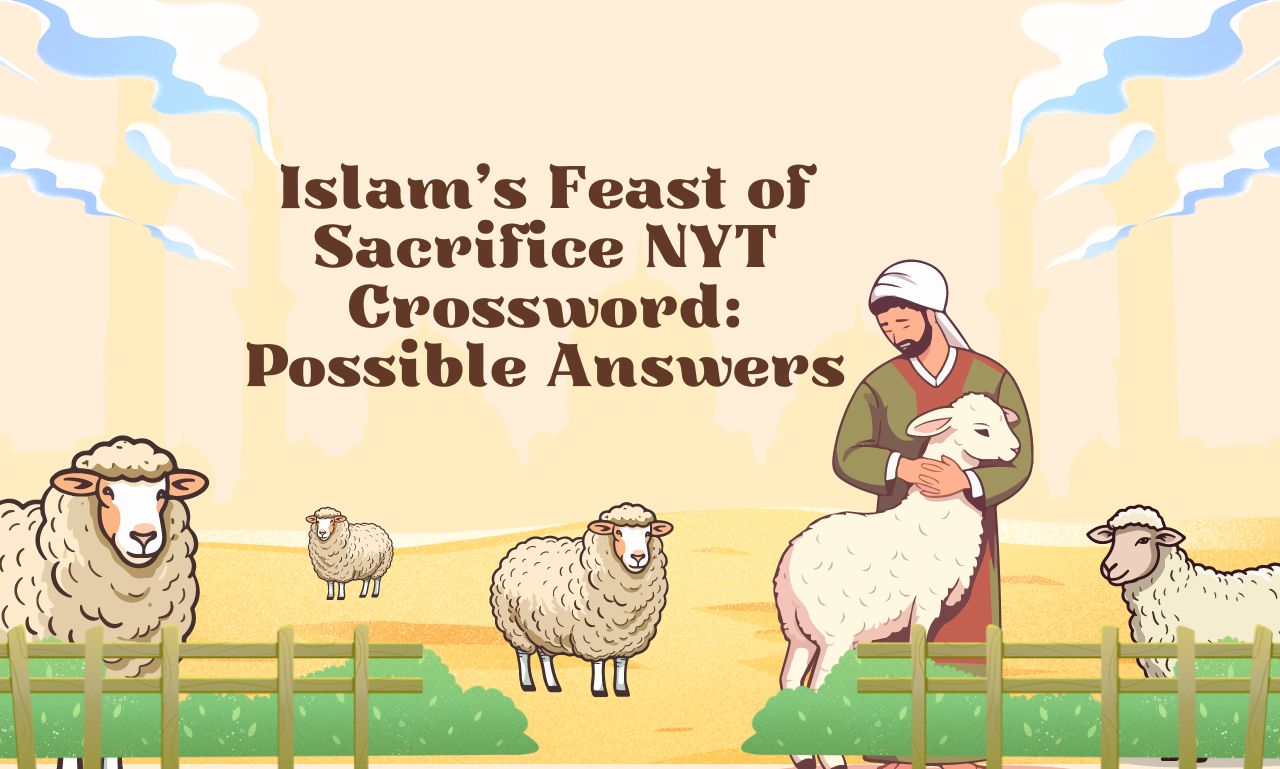In the vast and engaging world of crossword puzzles, the New York Times Crossword is one of the most popular and challenging. It often includes clues that reference cultural, religious, and historical events. One such clue that has piqued the interest of many solvers is “Islam’s feast of sacrifice.” Understanding the possible answers to the clue “Islam’s Feast of Sacrifice NYT Crossword” requires a basic knowledge of Islamic traditions and terminology.
Understanding the Clue: Islam’s Feast of Sacrifice NYT Crossword
“Islam’s Feast of Sacrifice” refers to a significant religious holiday in Islam, known for its deep spiritual meaning and communal practices. This holiday is commonly celebrated by Muslims around the world and involves the act of sacrificing an animal, usually a goat, sheep, or cow, in remembrance of the willingness of Prophet Ibrahim (Abraham) to sacrifice his son as an act of obedience to God.
This religious event is known by a specific name in Islamic culture, and understanding this term is key to solving the crossword clue.
Possible Answer: Eid al-Adha
The most common answer to the crossword clue “Islam’s Feast of Sacrifice” is “Eid al-Adha.” This term directly translates to “Festival of the Sacrifice” in Arabic. One of the two main Islamic festivals is Eid al-Fitr, which comes on the last day of Ramadan.
Eid al-Adha is a four-day event that begins on the 10th day of Dhu al-Hijjah, the last month of the Islamic lunar calendar. During this festival, Muslims around the world perform a special prayer and carry out the ritual sacrifice of an animal, symbolizing the act of devotion and submission to God, just as Prophet Ibrahim demonstrated. The meat from the sacrifice is often distributed among family, friends, and those in need, emphasizing the importance of charity and community in Islam.
Given its significance and the direct connection to the concept of a “feast of sacrifice,” “Eid al-Adha” is the most straightforward and accurate answer to this crossword clue.
Alternate Answer: Bakr-Eid
Another possible answer that may occasionally appear in crosswords is “Bakr-Eid.” This is an alternative name for Eid al-Adha, used primarily in South Asian countries like India, Pakistan, and Bangladesh. The term “Bakr” refers to a goat, which is commonly the animal sacrificed during the festival.
While “Bakr-Eid” is less common in crossword puzzles, it is still a valid and culturally relevant answer to the clue “Islam’s Feast of Sacrifice.” It is important for solvers to recognize this variant, especially when the crossword grid requires a different number of letters or when the puzzle is designed for a global audience.
Other Variants and Considerations
While “Eid al-Adha” and “Bakr-Eid” are the most straightforward answers, it’s also possible to encounter other variants or related terms in certain crossword puzzles. For example:
- Kurban Bayrami: This is the Turkish name for Eid al-Adha, literally translating to “Festival of the Sacrifice.” While it is less common in English-language crosswords, it may appear in puzzles that include foreign words or are themed around different cultures.
- Festival of Sacrifice: This is a direct translation of “Eid al-Adha” and could be a possible answer in puzzles that focus on translations or are aimed at a broader audience.
Conclusion
When encountering the clue “Islam’s Feast of Sacrifice NYT Crossword” in any puzzle, the most likely answer is “Eid al-Adha.” However, depending on the puzzle’s theme, structure, and regional focus, other variants like “Bakr-Eid,” “Kurban Bayrami,” or “Festival of Sacrifice” might also be correct.
Understanding the cultural and religious context behind these terms not only aids in solving the puzzle but also enriches one’s appreciation for the diversity represented in crossword puzzles. So the next time you come across this clue, you’ll be well-prepared to fill in the blanks with confidence.
FAQs About Islam’s Feast of Sacrifice NYT Crossword
1. What is the most common crossword answer for “Islam’s Feast of Sacrifice”?
The most common crossword answer for “Islam’s Feast of Sacrifice” is “Eid al-Adha.” This is the Islamic holiday that commemorates the willingness of Prophet Ibrahim (Abraham) to sacrifice his son in obedience to God.
2. Are there alternative names for Eid al-Adha that might appear in crosswords?
Yes, another name that might appear is “Bakr-Eid,” which is commonly used in South Asia. In some puzzles, you might also see “Kurban Bayrami,” the Turkish name for the festival.
3. How many letters are typically in the crossword answer for “Islam’s Feast of Sacrifice”?
The answer “Eid al-Adha” has 9 letters. However, if the puzzle requires a different number of letters, alternatives like “Bakr-Eid” (7 letters) might be used.
4. Could “Islam’s Feast of Sacrifice” have different answers depending on the crossword puzzle?
Yes, while “Eid al-Adha” is the most common answer, other variants like “Bakr-Eid” or even translated terms like “Festival of Sacrifice” could be used, depending on the crossword’s theme and format.
5. What does “Eid al-Adha” mean in English?
“Festival of the Sacrifice” is how the English term “Eid al-Adha” is translated. One of the two main Islamic holidays, it is celebrated by Muslims all around the world.
6. Why might “Bakr-Eid” be used as a crossword answer?
“Bakr-Eid” might be used as a crossword answer because it is a regional name for Eid al-Adha, particularly in South Asian countries like India, Pakistan, and Bangladesh. It is a valid alternative that crossword creators might use.
7. Is “Kurban Bayrami” a correct answer for “Islam’s Feast of Sacrifice”?
Yes, “Kurban Bayrami” is the Turkish name for Eid al-Adha and can be a correct answer in crossword puzzles that include or focus on foreign language terms.
8. Can the clue “Islam’s Feast of Sacrifice” appear in different crossword puzzles?
Yes, the clue “Islam’s Feast of Sacrifice” can appear in various crossword puzzles, including the New York Times Crossword, with slight variations in the answers based on the puzzle’s theme, structure, and audience.

